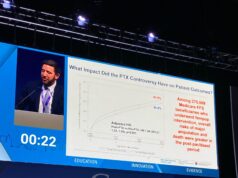
At the annual meeting of CIRSE, during an awards ceremony, the achievements of several world renowned interventional radiologists were celebrated—including a new award that recognised excellence and innovation in interventional radiology.
The new award—the RW Günther Award For Excellence and Innovation—was given to Amman Bolia, Leicester Royal Infirmary, Leicester, UK and Jim Reekers, Department of Radiology, Academic Medical Centre, University of Amsterdam, Amsterdam, The Netherlands, for their work in the development and promotion of subintimal angioplasty for the management of critical limb ischaemia. The president of CIRSE, Michael Lee, Radiology Department, Beaumont Hospital, Dublin, Ireland, said: “On behalf of the tens of thousands of patients with critical limb ischaemia whose limbs have been saved by interventional radiologists, and non interventional radiologists, using this technique, thank you.”
Also, at the awards ceremony, three leading interventional radiologists were recognised as being “distinguished fellows” of CIRSE, Götz Richter, Department of Diagnostic and Interventional Radiology, Klinikum Stuttgart, Bad Cannstatt Hospital, Stuttgart, Germany; Maâgorzata Szczerbo-Trojanowska, Department of Vascular and Interventional Radiology, Medical University Lublin, Lublin, Poland; and Kenneth Thomson, Alfred Hospital, Melbourne, Australia.
Johannes Lammer, Department of Cardiovascular and Interventional Radiology, Medical University, Vienna, Austria, who gave Richter’s laudation at the awards ceremony, said: “It was clear from early on that he would be a great pioneer and that he would have a great future.” Richter, who oversaw the first endovascular aortic repair (EVAR) of abdominal aortic aneurysms in Europe and also oversaw the first use of an iliac metal stent in humans, said that he was “very humbly honoured by this great appreciation of my career.”
Szcerbo-Trojanowska, whose main fields of interest are in vascular interventions (embolization, carotid stenting, and aortic aneurysm stent grafting) and who has won several awards for her work, also said she was honoured that she was being made a distinguished fellow. She added: “I am deeply touched to receive this award from the society with which I have identified myself during my whole professional life.”
According to Thomson, who founded the Interventional Radiology Society of Australasia in 1979 and who has published more than 120 articles, one of the most “humbling things” is for “your peers to recognise you and your efforts.” He added: “A lot of people have helped me with my career—mentors who have taught me from the start. There are people who took risks with me and gave me opportunities that they might not have.”
The final prize at the awards ceremony was the Gold Medal, which this year was given to Peter Müeller, Department of Radiology, Abdominal Imaging and Interventional Radiology, Massachusetts General Hospital, Boston, USA, to recognise his work in non-vascular interventional radiology (specifically, biliary intervention, abscess drainage, and percutaneous ablation of malignant tumours of the liver and kidney). Andy Adam, University of London, London, UK gave Müeller’s laudation and said: “I have lost count of the number of people I have met across the world who consider it a highlight of their career that they have worked with Peter Müeller.” Müeller said: “Joining all the people, who are tremendous leaders in their field, who have received an award at this ceremony and those who are previous awards winners is a huge honour.” He added: “The reason we get so much out of interventional radiology as a specialty is because we have so much fun doing it and we receive appreciation from the patients we work on—you do not get that with many specialties.”












